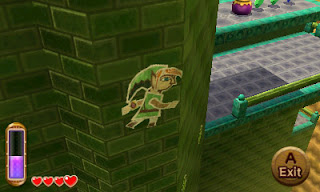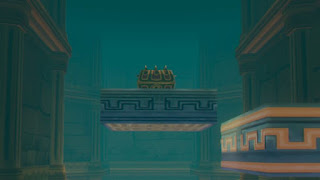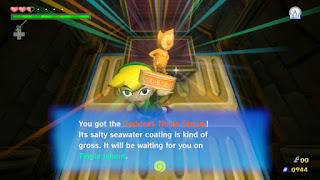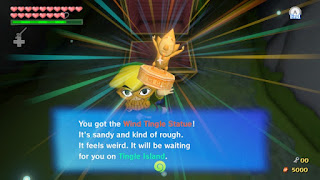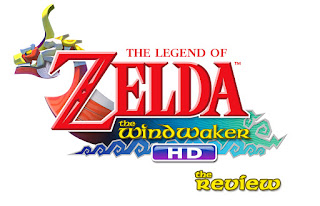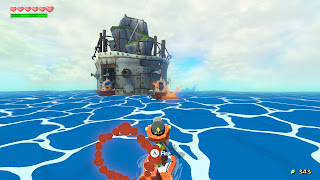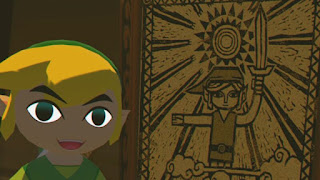This review was originally published on ZeldaChronicles (formerly known as ZeldaEurope) and got translated for this blog in 2021 by the same author.
With the Wii U and Zelda, Nintendo decided to take a similar route to the Nintendo 3DS: "Let's produce a remake / remaster and release a Limited Edition bundle to make sure that fans are going to buy it anyway". Take the black model, put some golden decals on it, bundle it with the game, done.
But this works and now it's time to review The Legend of Zelda: The Wind Waker HD on Wii U. Similar to Ocarina of Time 3D, this review will focus on the qualities of the remaster itself, not the original game. So, the focus will be on the changes when compared to the GameCube original, where the review can go in greater details and might contain some spoilers for all those, who have never played The Wind Waker before.
Overview
It's been ten years since the release of The Wind Waker for the Nintendo GameCube and at its time it was quite the controversial topic for Zelda fans. After Nintendo had presented a more realistic Zelda for the next generation at SpaceWorld 2000, the surprise came one year later with the cartoony cel shading visuals. Instead of a serious, adult Link we got "Toon Link", who expressively fought his way through equally expressive Moblins. And it certainly wasn't what everyone had expected for the future of Zelda at the time.
Now, ten years later Toon Link is everywhere – he is iconic and the symbol of the Zelda franchise's diversity in art styles. And those, who disliked the toon style originally, might have warmed up to it by now and gave The Wind Waker a second chance – maybe even now with The Wind Waker HD, where the game is experiencing its renaissance on Wii U.
Whoever is already familiar with the GameCube original knows that it's a carefully crafted game with timeless visuals, which weren't actually a negative, but one of the game's strengths. The Cel Shading is in perfect harmony with the ocean, which for the first time became the setting for a Zelda game. But The Wind Waker also surprised with its story, which for the first time referenced previous generations of Zelda's history with the events of Ocarina of Time. It was clear from the start that you're playing a completely new Link in a very different time.
While the visuals, the atmosphere, the story and gameplay of the original were quite good, it didn't come without any shortcomings. Often criticized were the low difficulty or the slow pacing, while two dungeons didn't make the cut and the endgame's Triforce hunt wasn't for everyone's liking. But those are even more good reasons for a remaster, where The Wind Waker HD is the perfect opportunity to not only show off the game in HD, but also improve some it on some ends for a better gaming experience... So, let's take a look at how good the remaster really is.
Graphics & Sound
If you were to ask Zelda fans which game should be getting an HD update, Majora's Mask or Twilight Princess would come to mind, but not necessarily The Wind Waker. Unlike Twilight Princess, the graphics of The Wind Waker have aged remarkably well. The cel shaded visuals still look good today, where the original can already create some stunning pictures when properly upscaled.
It's a timeless style, but that's probably the main reason, why Nintendo went for this remaster. Let's not fool ourselves here: The Wind Waker HD exists mainly because it was easy to make. Nintendo has confirmed as much, where only a handful of people were working on this title for about half a year, while the rest of the Zelda team at Nintendo EAD3 were busy with the new game for Wii U and A Link Between Worlds.
But sometimes it's enough to put things into a different light. The 3D models and environments were ported from the GameCube game over to the Wii U, while the textures have been reworked by Hexadrive. Add some bloom and other shading effects to it all and there you have your HD remaster. While for Ocarina of Time 3D the developers put a lot of work into new models and adding more details to the environments, you get none of that here. The Wind Waker HD takes the original and shines a new light on it.
This might sound disillusioning, but in the end this is all that was needed to create one of Wii U's most impressive looking games. From the moment on where you set your feet back on Outset Island and see the place bathed in sunlight, you can't take your eyes from this game. It's eye candy and the Great Sea has never looked better, where the new lighting makes it even feel more realistic and alive, all in harmony with the toon shading of the original.
What works great for the outside, doesn't really look so good on the inside, however. In the original the interiors of houses and dungeons were lit by an ambient light, where there's no perceptible light source. But the remastered version now took its new shading effects and applied them to indoor environment as well, which just looks weird and wrong. There are shadows casts on places that shouldn't have any shadows and where you can't tell where the light is coming from. It even creates bizarre scenes, where doors and pillars cast shadows, but not the walls surrounding them. And once you start noticing these details, they can be very distracting Take this shot of the Wind Temple for example:
Where does the light come from? Why do the pillars have shadows, but not the walls? The dungeons would have required some actual light sources (like lanterns) instead of some global lighting that's coming from behind the walls, removing any authenticity from the scenes.
When there are lanterns and such present, however, they shine with soft color transitions, where this technically isn't cel shading any longer, where there's clear cuts between different colors. But this also makes Toon Link often look more like Clay Link, which is even the case, whenever he shows off some item from a treasure chest, which casts a light on him, making him look quite odd...
It also doesn't seem like the engine was improved much, where there are even frame drops in the same places as in the original, like certain boss fights or intense battles on the sea. And that's quite the disappointment, considering how this is a ten year old game running on Nintendo's newest console.
Also, it didn't really improve the loading very much. Aonuma claimed that the entire ocean could be loaded at once (see the Developer Direct), but you don't really notice that while playing. While you're traveling on the ocean, enemies and other entities still appear from nowhere right in front of you and you can clearly see how certain details of islands only pop in while you're approaching. It's still better than on the GameCube, however, and you don't notice how it loads between quadrants any longer.
And those who have played Ocarina of Time 3D and hope for a similar overhaul from The Wind Waker HD, will ultimately be disappointed. With the 3DS remake it felt like experiencing the classic from a new perspective, where there were new details everywhere. But with The Wind Waker HD you'll be getting the same old game with some new lighting effects. It can look very pretty, but it's still the same old.
Unlike Ocarina of Time 3D, however, not only the graphics were overhauled, but the sounds as well. Mainly some of the shorter music pieces, like for opening a treasure chest of playing the Wind's Requiem, got new versions in orchestrated quality. Some of the longer songs, like Windfall Island, also got new versions, but not every song in the game got remade... Some more re-orchestrated music would have been nice, but at least the remaster also offers something new for the ears and not just the eyes.
Controls & Interface
Not only the timeless visuals made The Wind Waker the perfect choice for Nintendo's first HD remaster on Wii U, but also the fact that the game was practically made for the Wii U GamePad. On the GameCube you often came into situations, where you had to switch between menus and game, often to do simple things like salvaging treasures.
You won't have this problem on the Wii U any longer, at least not as long as you play with both the TV and the Wii U GamePad, because in that case you can go through menus, change your items, navigate maps and read Miiverse messages all while the game is running. You can still pause the game, if you need to, but using the GamePad during your sea travels is certainly practical and let's you navigate to sunken treasures on your map with absolute precision.
You can swap your items traditionally by pausing the game, but you can also flip them onto the button slots via the touchscreen without any bigger interruption of the gameplay. Plus, you don't need to assign certain items to buttons any longer, where for example the Wind Waker itself can now quickly be used via the D-Pad.
The Sailcloth is now also gone from the item menu and can be used with the A-button whenever you're on the boat. In addition, both the cannon and the crane can now be activated via the D-Pad and then controlled with the A-button, so that you don't have to put Bombs and the Grappling Hook on your items slots (but you still can, if you want). On the GameCube you had to switch between items while traveling with the Red King of Lions quite often, but in the remaster your item slots are free for other things, like the Bow, which is certainly practical and more comfortable.
It's also of note that The Wind Waker HD offers an unusual amount of options, at least when compared to other Zelda titles. You can turn off motion controls, reduce the HUD and invert axis for both the normal camera and the first person camera. However, for the normal camera you can only turn off the inverted axis for moving left and right, bot not up and down, so it's not perfect.
You can also play the game directly on the Wii U GamePad or via a Pro Controller. In both cases you won't have the advantage of using menus and maps in parallel, but it's still a plus that Nintendo lets you choose freely what works best for you, mainly for those who want to keep it close to the GameCube original.
However, you won't be able to play it exactly like on the GameCube. Nintendo has changed certain aspects of the controls, where some of these changes make sense and feel right, while others might feel counter-intuitive, especially if you're used to the GameCube original. Then it might happen that you push a wrong button or the game doesn't react the way you expect it to, where it takes some getting used to.
This mainly goes for the first person controls, where you now can move around freely, similar to Skyward Sword. This can give you a big advantage in certain situations, but the downside is that you now need to aim with the right analog stick, in case you're playing with the Pro Controller or don't want to rely on motion controls, in which case items set to the X or Y buttons don't work too well, where you're stuck with the R button.
A better solution would have been, if it worked like in Metroid Prime and you could simply switch between walking and aiming with the L button. But if you're playing with the Wii U GamePad the controls are really good, especially the aiming via motions, which is similar to Ocarina of Time 3D and offers a new level of precision.
There are also some new gimmicks, where for example you can now control Link via the touchscreen while he's conducting. You will also be able to read all the songs on the touchscreen, similar to Ocarina of Time 3D.
You can also now read the hints of the fishmen on your map, so you don't have to spend more All-Purpose Bait on them and you can study their wisdom from anywhere. However, the info what kind of sunken treasure was found at a certain island is now gone, where it would have been nice, if both the fishmen and the treasure info were on the map.
But the only thing that really seems to be missing is some way to draw or mark things on your maps, similar to Phantom Hourglass and Spirit Tracks. This way you could cross off the different platforms, Blu ChuChus and so on, but sadly the game doesn't offer anything like it, where you're still stuck with a piece of paper, if you really want to 100% clear the Great Sea.
Game Flow
As discussed in a blog post from two years ago, one of the biggest problems of the original game was its terrible pacing. Gameplay was often interrupted, sailing could take forever and for every change of the wind direction you had to play the Wind's Requiem, which was quite annoying. And certain things like the Grappling Hook didn't work too well. Luckily, Nintendo has addressed nearly everything in the remaster for a much better gaming experience.
The biggest improvement probably came with the Swift Sail, which increases sailing speed by 80% and magically turns the wind with the boat, so you're always having the vital momentum of a tailwind. It's the salvation for everyone who found the sailing in the original to be too tedious. To go full speed ahead without worrying about the wind direction is a lot of fun and makes the sailing so much more tolerable, where you might even ignore the warping in this version, simply because you can go so fast from A to B anyway. Going back to the original GameCube version will be hard after this.
The old sail doesn't become obsolete because of this, however. With the high speed of the Swift Sail your boat gets harder to steer, where you might switch back to normal Sail for more precision. Luckily, this is easily done via the A button, which lets you switch between the two sails at any time.
Navigating can also be a little bit harder without a fixed wind direction, because normally it was an indicator of where you wanted to go, but now you have to make use of the compass needle in the bottom left corner of the screen. This was already there in the original, but it wasn't really that important and you might not even remember this feature, because the wind was usually good enough for orientation. And of course you can also use the map on the GamePad screen.
You also have to find the Swift Sail at first. It's not served on a silver platter and there are only few hints, where you might get this magic sail. It might even happen to some players that they play through the entire game with the slow, old sail, because they aren't really invested in side quests and simply missed the faster traveling option. But you can get the Swift Sail as soon as completing Dragon Roost Island, which is very early in the game, so that you can make use of it for the majority of your sea travels.
But the Swift Sail is not the only item, which does things faster now, where the Grappling Hook would be another example. In the original you basically had to watch a small cutscene of how it gets attached to a pole, where the game flow was interrupted with every use of the item. Sometimes you also had to change the direction of the swinging, where you needed to stand perfectly still at first...
The cutscene is still there, but at least it's three times faster and you can now change direction while swinging. Especially when going to Forest Haven this is clearly noticeable how much this feature has improved. It's not as fast and ideal like the Whip in Skyward Sword, but still a lot better than it used to be on the GameCube.
That's all great, but there are even more time savers on top of that. Texts now run much faster and the salvaging of treasures only takes half as long. Also, once you've played a song, it won't be repeated the next time, but the effect gets activated immediately. This is a blessing for something like the Command Melody, which have to play very often inside dungeons to switch between characters. It's not as easy as pushing a button to do it, but still already much faster than in the original.
However, there are still things that The Wind Waker HD could learn from other Zelda games, like the Ending or Fatal Blow in Twilight Princess and Skyward Sword, which eliminates enemies on the ground. The Wind Waker introduced the possibility of knocking down enemies, but they are completely invulnerable during this, which removes the flow out of certain fights, because you're now waiting for the enemy to recover... With some enemies, like the Magtails, such a finishing blow even exists, but it's not available for Bokoblins, Moblins and alike.
But overall The Wind Waker HD did a great job at improving the game's speed and flow, where replaying it all has become much more enjoyable.
Triforce Quest
There is another big optimization to the game's pacing with the infamous search for the eight Triforce Shards, but this deserves a section of its own. This whole part of the game has always been controversial, where some liked it, but others might have lost motivation.
For the eight Triforce Shards you had to first find eight Triforce Charts all over the world and then have them translated by Tingle, a character as controversial as the entire Triforce hunt itself. But of course he doesn't do it for free, where he wanted 398 Rupees per Triforce Chart, which marks the first time in the Zelda series, where the players had to find large sums of Rupees to make progress in the game. And after translating the eight charts, you had to find and salvage eight treasure chests from the bottom of the ocean...
It's a lot of things that you'd expect to do as side quests, but instead it's all part of the main quest right before the end of the game, which seemed to be a popular design choice for the GameCube era. Both Metroid Prime and Metroid Prime 2: Echoes did this as well with the Chozo Artifacts and the Sky Temple Keys, just that the search for the Triforce Shards is a lot more convoluted than the search for those.
For people, who just want to play through the story, this can be hard to endure. But not everyone hated the idea, where some might have also enjoyed collecting all the Triforce Shards, which is why it's good that Nintendo steered a middle course here, where they didn't remove the hunt for the Triforce Shards, but toned it down a bit.
The solution was quite simple: in The Wind Waker HD you will get five of the Triforce Shards directly in the places, where their Triforce Charts would have been. So, there are only three Triforce Charts left (certainly a fitting number), which need to be translated by Tingle, where this makes the whole process a lot faster and cheaper.
The nice thing is that this even still works, story-wise. The five Triforce Shards without a chart are for the most part found in underground mini-dungeons, which could be theorized to be part of the old Hyrule. It's in a way quite similar now to the first The Legend of Zelda game, where the Triforce of Wisdom was split into eight shards that are found in Hyrule's dungeons. And getting the Triforce Shard themselves inside these mini-dungeons now feels a lot more rewarding.
The three Triforce Charts that you still need to get are also the ones that you could do very early in the game with tasks on the open ocean. So, it even makes sense here that these Triforce Charts are still where they are.
(The only nitpick here is that the Triforce Shard sunken near Outset Island is now gone, where it always felt special to return to Link's home to collect a piece of the Triforce. But this is not a big deal.)
And it's not like the five Triforce Charts that were removed now leave any gaps. Instead you can now find five new Treasure Charts in various places, where originally you would only find Rupees or spoils, which makes visiting these places now more worthwhile. And that's great.
Rupees
With five of the Triforce Charts gone you save almost 2000 Rupees in the HD remaster. Plus, getting the 1200 Rupees for the ones that are still there should now be easier than ever. All the Light Rings on the open ocean, which indicate the location of a sunken treasure, now all lead to chests with 50 Rupees instead of 20, making them more worthwhile. And with that it's very easy to amass riches in The Wind Waker HD, where you don't have to worry about Rupees at all.
To compensate this a little bit the Magic Armor now works more like its name twin from Twilight Princess: it doesn't consume magic any longer and instead it costs you Rupees, whenever enemies are hitting you. Unlike the one from Twilight Princess it doesn't consume Rupees all the time, so you run around with the barrier as you see fit. But be aware that being hit can be costly, where a Darknut might cause "damage" in the triple digits. But it's certainly a good way of burning Rupees.
Tingle Bottles & Miiverse
Next to the Swift Sail, there's a second new item in the game now: Tingle Bottles. They allow you to directly receive and put out Miiverse messages from your game and demonstrate how a well done Miiverse integration looks like.
Miiverse is basically Nintendo's own Twitter for their games. Every game gets its own community for messages, drawings and screenshots. You can use Miiverse to share your creative moments, to grab about ingame achievements or to get help from other players.
This is all quite nice, but normally you have to interrupt your game and open Miiverse to do any of this. And some players might not even bother with that. With the Tingle Bottles in The Wind Waker HD, however, Nintendo found a charming solution for this issue. Using this item lets you directly post to Miiverse without interrupting the game, which all works via messages in Tingle-shaped bottles.
The nice thing about this is that these bottles can also be washed into your game world. You can find them on any beaches or on the open sea, where you can collect them like Rupees or other normal items. They are distributed rather well and collecting them can be quite addicting, even though you won't always get the most useful posts.
This is especially nice during your boat tours, where the Tingle Bottles now give you something to find on the otherwise rather empty waters. And you can even read the messages on your Wii U GamePad while you're still sailing as a nice distraction, where in combination with the new Swift Sail this makes the boat trips a lot less boring.
Naturally, this depends quite a lot on the community, but while playing The Wind Waker HD in its early days the messages were for the most part surprisingly pleasant. Many of the posts are funny or helpful, where Nintendo does a good job of keeping the Miiverse clear of troublemakers.
Since Nintendo doesn't want you to miss the Tingle Bottles, you now have to free Tingle in Windfall Island, before you can buy the normal sail. But since you need Tingle to make progress later in the game, this is a thoughtful change in any case.
The Tingle Bottles are the replacement for the Tingle Tuner, which let a second player join the game via GameBoy Advance on the Nintendo GameCube to "support" the main player with bombs and other things. It seems somewhat ironic that this has been cut of all things, since the Wii U GamePad would have been perfect for such a feature.
But to be fair, it wasn't the best feature ever and felt more like a cheat tool, where you can buy invulnerability or refill your hearts for Rupees. And while the intention was for it to be a two player tool, where some might miss this, many just used this on their own to get the exclusive rewards...
Speaking of, the five golden Tingle Statues, as well as Tingle's missing brother Knuckle are still in the game, despite the missing Tingle Tuner. Knuckle will appear, once you've obtained all five statues and the Nintendo Gallery won't be considered complete without him now.
Curiously, the statues are hidden in the same obscure spots as in the original, but this time you won't be getting any hints where to find and how to find them. So, if you haven't played the original version of the game and did the Tingle Tuner quests there, you either discover the statues by sheer accident or you learn about them from the internet... And maybe it was even Nintendo's intention that people will use the Miiverse to find out about this secret, where people are actually sharing these kind of things.
But it shows that Nintendo is willing to include some well hidden secrets into their games again, where it makes you hopeful that they let their players into the wild without constant hints. If all fails, you can always seek help right away via Miiverse, where this could be one of the best things that have happened to Zelda in a while.
The only real problem with Miiverse are spoilers. You can mark your posts as a spoiler, but you might forget to do so. You can report unmarked spoilers, but in that case it might be already too late for you. And not everyone shares the same sentiment what counts as a spoiler and what doesn't. Of course this isn't really problematic for a ten year old game as The Wind Waker, but receiving pictures of the final boss in a new Zelda game would certainly be an unpleasant surprise, so Nintendo has to handle this with great care for the future.
Picto-Box & Nintendo Gallery
The Miiverse also brings another item in the spotlight: the Picto Box. You can now directly put your pictures into the Miiverse via the Tingle Bottles and to give these pictures a certain charm the Picto Box also lets you do funny selfies, where you can choose between ten different facial expressions. This is so much fun that the majority of pictures in the community for The Wind Waker HD are selfies, yet this never gets old. Especially silly scenes, like Toon Link posing in front of a dangerous boss, are always fun, where this could be the best addition to this remaster overall.
Luckily, the Picto Box can now store up to twelve pictures, instead of just three, which should encourage the players to take more photos during their adventures. It's also now easier to get the Deluxe Picto Box, where it's even possible to do so now on your first visit on Windfall Island.
You still need to become Lenzo's research assistant and complete the tasks he gives you, but you don't need a Forest Firefly any longer. Therefore this item doesn't have any real use in this version of the game, other than trading them for Joy Pendants. This might seem like a rather drastic change at first, but considering how many pictures on Miiverse are still in black and white, where players have no clue how to upgrade the camera, it probably would have been better to skip the normal Picto Box altogether.
But let's not forget what the Picto Box was originally for: collecting figurines. There's the Nintendo Gallery at Forest Haven, where Carlov will craft you a figurine, if you show him a good picture of a character, an animal or a monster.
There's 134 of them to collect and in the original version of the game on the Nintendo GameCube this was quite the task to complete, since you were limited to carrying three photos at once. This resulted in a lot of back and forth, while there was also the risk that Carlov didn't like the picture. And that could be especially annoying for the eight shots that can be missed entirely, where the respective person or monster can't be found later in the game. Plus, for each figurine you needed to let time pass til the next day...
Needless to say that this was one of the slowest and most cumbersome side quests in the history of the Zelda series, where The Wind Waker HD improves this on almost all fronts. As already mentioned, you can now save up to twelve pictures, but Carlov can also craft twelve figurines at once, which will save you a lot of time and traveling.
In addition, your pictures will now have a special Carlov seal on them, if they are good enough for a figurine. So, you can always be sure that your photo will do the trick in advance and you don't have to make multiple pictures of the same being multiple times, which is especially helpful for the various boss monsters and the few people that can be missed. And if you happen to still miss one of them, you now also have the option to use a picture from a Tingle Bottle.
For example if you forgot to take a picture of Tetra at a certain point in the game, not all is lost. In the original you had to wait until the 2nd Quest to finally take a picture of her, but in The Wind Waker HD you might find a good photo of her posted by the community for this very purpose. It's truly neighborly help among Zelda fans, which also shows how useful the Miiverse integration into this game can be, where everyone now should be able to complete their figurine collection on the first playthrough. (Sadly, Miiverse was shut down later in 2017, where this doesn't apply any longer.)
You now also can't miss Knuckle's figurine any longer, as already mentioned, but the figurine of Kogoli, some random Rito who disappears from Dragon Roost Island later during the game and never returns, is still missable. It would have been nice, if they fixed that as well, because that one is really hard to predict. But otherwise Nintendo has done everything to make the figurine hunt a lot more enjoyable.
Hero Mode
One thing many people complained about The Wind Waker was the low difficulty, where the game was way too easy and you never were at risk of dying, which could be quite disappointing for skilled players. Nintendo tries to improve things here with the "Hero Mode", which got introduced in Skyward Sword. Enemies will cause double the damage and hearts are normally not found, so that you can only heal up by using potions and fairies. Unlike in Skyward Sword there is no way of making hearts appear anyway and there are also fewer ways of healing yourself.
This can be quite challenging in the early game, where you might get into some hairy situations with no healing in sight. But the more Heart Containers and bottles you get, the less this will actually make a difference and put you in real danger. It's still an interesting change to have such limited healing possibilities overall.
Nintendo also listened to the fans who didn't like that you had to unlock Hero Mode in Skyward Sword by playing through the game once. In The Wind Waker HD the Hero Mode is now an option, which can be toggled on and off whenever you're selecting the game file. This means you can play in Hero Mode right from the start, which is great for veterans, but you can also turn it off at any time, in case things are getting too difficult for you.
It's not ideal for those bragging rights, however, because there is no indication whether a save file was completed in Hero Mode or not. So, maybe in the future you should get a choice between normal and Hero Mode right from the start, but you need to stick to that choice. In any case it's an option that shouldn't be missed in new Zelda games.
It's not an option that truly makes a Zelda game more difficult on all ends, however, where the "Master Quest" version of Ocarina of Time (3D) did a much better job here. Difficulty in Zelda games isn't just about combat and survival, but also puzzles or navigation, where the "Hero Mode" in Skyward Sword and The Wind Waker HD doesn't change any of that.
New Content?
If you know and loved the original game, there is mainly one thing that you might want to know about a remaster: is there anything new to discover? The Wind Waker probably is one of the most expandable Zelda games, where originally the game was supposed to have two more dungeons that didn't make the cut. Some fans have obsessed over these for many years, while others might be hoping to find more on the Great Sea, where it's rather empty and often feels like it was filled by using "copy & paste" with its various similar islands, watch towers, submarines and so on. Or you might not care about the ocean or dungeons at all and rather explore the sunken lands of Hyrule below...
There were many starting points to expand The Wind Waker and its experience, but Nintendo didn't explore any of this. Other than the new Swift Sail, the Tingle Bottles and the five new Treasure Charts (replacing the respective Triforce Charts) there isn't really anything new to discover for fans of the GameCube original. So, if you're hoping for new dungeons, islands, ships or quests, then you will be disappointed by The Wind Waker HD, where this feels like a missed opportunity on Nintendo's end.
Another possibility of changing the game in interesting ways would have been the 2nd Quest, which is still present in the remaster, but remains completely unchanged. Like in the original you get to use Link's blue outfit through the entire game, while his sister Aryll wears her pirate dress all the time. You can now understand the Hylian language and Treasure Charts have their locations slightly altered to make them harder to read. And you get the Picto Box Deluxe right from the start now, while your previously collected figurines are also still there, where completing this collection was probably the main reason to play the 2nd Quest for many. But since this can be done a lot more easily now during your first playthrough in The Wind Waker HD, the 2nd Quest kind of loses its edge here.
In the least they could have done some simple things, like mirroring the game world, similar to the "Master Quest" mode in Ocarina of Time 3D. Imagine having Outset Island in the southeast and Dragon Roost Island in the northwest. Or they could have taken advantage of the game's grid system to swap the locations of various islands on the map. Anything would have helped to provide a fresher experience...
Conclusion
With The Wind Waker HD Nintendo tried to utilize smaller changes for great effect, where this applies to graphic and gameplay alike. There hasn't changed much, but what has changed positively effects the entire game.
Once you've played the HD version, there is no going back to the original. Especially the Swift Sail and the improvements for the Picto Box are things that you wouldn't want to miss any longer. The game was also streamlined on various ends for a better experience and looks for the most part quite gorgeous with the new lighting effects.
The biggest downside of this remaster is that there is little new to discover, where it's hard to recommend this to players, who have already completed the original on GameCube and who want something new out of this. But if you haven't played either version yet, then it's highly recommended to go with this one, since it improves The Wind Waker on many ends and offers the better experience overall.
The Good:
-
Stunning visuals on the ocean and islands
-
Some updated tracks in orchestral quality
-
Various control options
- Nice controls with the Wii U GamePad
-
Swift Sail and other fastened actions
-
Streamlined Triforce Quest makes sense
-
Hero Mode adds some challenge
-
Fun and useful Miiverse integration thanks to Tingle Bottles
-
Improved Picto-Box & Nintendo Gallery
-
Five new Treasure Charts
The Bad:
-
Weird indoor visuals
-
Frame drops like in the original
-
Counter-intuitive control changes
- Can't draw on maps
-
No new or changed environments
-
No enhanced 2nd Quest






